Maryland's 2nd congressional district
Maryland's 2nd congressional district elects a representative to the United States House of Representatives every two years. The district comprises parts of Howard, Harford, Baltimore, and Anne Arundel Counties, as well as small portions of the City of Baltimore. The seat is currently represented by Dutch Ruppersberger (D).
| Maryland's 2nd congressional district | |||
|---|---|---|---|
.tif.png) Maryland's 2nd congressional district since January 3, 2013 | |||
| Representative |
| ||
| Area | 359 sq mi (930 km2) | ||
| Distribution |
| ||
| Population (2013) | 745,135 | ||
| Median income | $68,204[1] | ||
| Ethnicity |
| ||
| Occupation |
| ||
| Cook PVI | D+11[2] | ||
Historical boundaries
When it was first organized in the late 1780s the Maryland 2nd Congressional district consisted of the northern portion of the eastern shore of Maryland and the area where the Susquehanna River empties into the Chesapeake Bay. It had a population of 55,008 in 1790.[3]
After the 1790 census Maryland gained two seats in the house. The new 2nd district essentially consisted of Howard County, Prince George's County and Anne Arundel County. The boundary ran on a line heading north-east from the north-west corner of the District of Columbia so that a small portion of Montgomery County was also in the 2nd district.[4]
This remained the boundaries of the district until the post-1830 census redistricting. At this time the 2nd district was moved back to the eastern shore region where it had been at first. The only change between the district's boundaries in 1790 and those in 1834 was that in the latter year Caroline County was part of the 2nd district.[5]
In the 1842 redistricting, which involved a decrease in the total number of representatives, Maryland went back to having only six members of the house. The second district was moved again and now composed the Maryland Panhandle, that is all of Maryland starting with Frederick County and going west.[6]
The post-1850 census redistricting caused another drastic redrawing of Maryland's congressional districts. The second district was moved back to the East side of the state. However this time it only had the eastern shore as far south as Kent County. However going westward it had Harford County, northern and western Baltimore County and the western and most southerly portions of Baltimore. It also took in Carroll County.[7]
In the 1862 redistricting process Maryland was reduced to having only five congressional districts. The second was cut down in size though to only having Harford County, eastern and northern Baltimore County including some areas now within the city boundaries on Baltimore.[8]
In the 1872 redistricting Maryland rose to six districts. However the area of the 2nd district increased. This was partly because it lost some of its area on the east side of Baltimore to the third district. It now also consisted of virtually all of Baltimore county, and the northern reaches of Baltimore. Cecil County was returned to its area, but Kent County remained in the first district. Carroll County was also put back in the second district. Thus the second district in 1873 was closer to that of 1853 than of 1871 in terms of the area within its boundaries.[9]
In 1890 there was a small portion of the city of Baltimore that was moved from the 4th district and placed in the 7th district. It appears this was in the general area where Freemont meets Fulton and then a little further south along Freemont.[10] These boundaries remained until the 1898 elections. In that year a few more north-west Baltimore neighborhoods were transferred from the 4th to the 2nd district, as well as a few north-central Baltimore neighborhoods.[11]
In 1902 another change was done to congressional district boundaries in Maryland. With the northward growth of population in Baltimore the 4th and 3rd districts boundaries were moved into areas previously in the 2nd district. however areas in north-west Baltimore that were closer to down-town were shifted into the 2nd district. Cecil County was moved to the first district. The arm of Baltimore County around Arbutus had long been in the 5th District but at this point it was transferred into the 2nd district.[12] These remained the boundaries of the 2nd district for the next 50 years.
In 1952 Maryland redrew its congressional districts because it had gained another seat in Congress. The 2nd district lost all of its area within the city of Baltimore, so it now consisted of Baltimore, Carroll and Harford Counties.[13]
In 1966 Maryland redrew its congressional districts to follow the rule of "One man, one vote". This was especially necessary since the state had been electing one of its congressmen at large in the previous two elections. A portion of Baltimore County along Baltimore's north-east border was removed from the 2nd district. The Arbutus section of Baltimore county was also removed from the district along with a slightly further north portion of the county reaching to about Garrison. Most of Carroll County was moved to the Maryland panhandle based 6th district.[14]
In 1972 Harford County was moved to the First District. The remaining portion of Carroll County was moved to the 6th district. However the Garrison area of Baltimore County, all of Baltimore county east of Baltimore and even a very small part of Baltimore itself were moved back into the second district.[14]
In 1982 some of the areas that had been in the 2nd district just north and west of Baltimore were moved into the Maryland Congressional 3rd District. Also at this time a part of Harford County was moved back into the 2nd congressional district.[15]
In 2012 the district was found to be the eleventh least compact congressional district in the United States.[16]
Recent election results in statewide races
| Year | Office | Results |
|---|---|---|
| 2000 | President | Gore 57%–41% |
| 2004 | President | Kerry 54%–45% |
| 2008 | President | Obama 60%–38% |
| 2012 | President | Obama 62.9%–35.1% |
| 2016 | President | Clinton 60.2%–35.6% |
| 2018 | Governor | Hogan 56.3%-43.2% |
Recent elections
- 2006 United States House of Representatives elections in Maryland
- 2008 United States House of Representatives elections in Maryland
- 2010 United States House of Representatives elections in Maryland
- 2012 United States House of Representatives elections in Maryland
- 2014 United States House of Representatives elections in Maryland
- 2016 United States House of Representatives elections in Maryland
- 2018 United States House of Representatives elections in Maryland
List of members representing the district
| Member | Years | Congress | Party | Electoral history | |
|---|---|---|---|---|---|
| 1 |  Joshua Seney |
March 4, 1789 – December 6, 1792 |
1st 2nd |
Anti-Administration | Elected in 1789. Re-elected in 1790. Resigned to become Chief Justice of Maryland's 3rd Judicial District. |
| Vacant | December 6, 1792 – January 30, 1793 | ||||
| 2 | 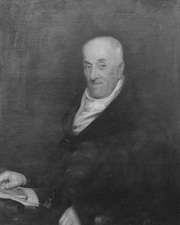 William Hindman |
January 30, 1793 – March 3, 1793 |
2nd | Pro-Administration | Elected January 7, 1793 to finish Seney's term and seated January 30, 1793 having already been elected in the 7th district. |
| 3 | 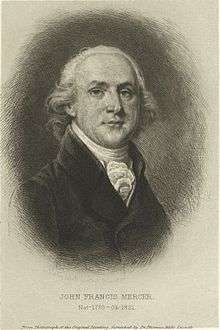 John Francis Mercer |
March 4, 1793 – April 13, 1794 |
3rd | Anti-Administration | Redistricted from the 3rd district and re-elected in 1792. Resigned. |
| Vacant | April 13, 1794 – November 11, 1794 | ||||
| 4 | 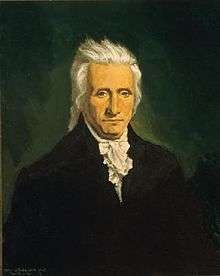 Gabriel Duvall |
November 11, 1794 – March 3, 1795 |
3rd 4th |
Anti-Administration | Elected May 5, 1794 to finish Mercer's term. Elected in 1794. Resigned to become Chief Justice of General Court of Maryland. |
| March 4, 1795 – March 28, 1796 |
Democratic-Republican | ||||
| Vacant | March 28, 1796 – May 5, 1796 | ||||
| 5 | Richard Sprigg Jr. | May 5, 1796 – March 3, 1799 |
4th 5th |
Democratic-Republican | Elected to finish Duvall's term. Re-elected in 1796. Lost re-election. |
| 6 |  John Chew Thomas |
March 4, 1799 – March 3, 1801 |
6th | Federalist | Elected in 1798. Lost re-election. |
| 7 | Richard Sprigg Jr. | March 4, 1801 – February 11, 1802 |
7th | Democratic-Republican | Elected in 1801. Resigned. |
| Vacant | February 11, 1802 – March 24, 1802 | ||||
| 8 | Walter Bowie | March 24, 1802 – March 3, 1805 |
7th 8th |
Democratic-Republican | Elected March 2, 1802 to finish Sprigg's term. Re-elected in 1803. Retired. |
| 9 | Leonard Covington | March 4, 1805 – March 3, 1807 |
9th | Democratic-Republican | Elected in 1804. Lost re-election. |
| 10 | Archibald Van Horne | March 4, 1807 – March 3, 1811 |
10th 11th |
Democratic-Republican | Elected in 1806. Re-elected in 1808. Retired. |
| 11 | 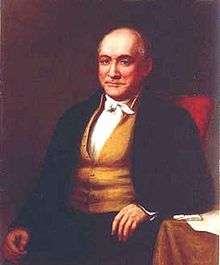 Joseph Kent |
March 4, 1811 – March 3, 1815 |
12th 13th |
Democratic-Republican | Elected in 1810. Re-elected in 1812. Lost re-election. |
| 12 |  John Carlyle Herbert |
March 4, 1815 – March 3, 1819 |
14th 15th |
Federalist | Elected in 1814. Re-elected in 1816. Retired. |
| 13 |  Joseph Kent |
March 4, 1819 – March 3, 1823 |
16th 17th 18th 19th |
Democratic-Republican | Elected in 1818. Re-elected in 1820. Re-elected in 1822. Re-elected in 1824. Resigned to become Governor of Maryland. |
| March 4, 1823 – March 3, 1825 |
Adams Democratic-Republican | ||||
| March 4, 1825 – January 6, 1826 |
Anti-Jackson | ||||
| Vacant | January 6, 1826 – February 1, 1826 | ||||
| 14 | John Crompton Weems | February 1, 1826 – March 3, 1829 |
19th 20th |
Jackson | [data unknown/missing] |
| 15 | Benedict Joseph Semmes | March 4, 1829 – March 3, 1833 |
21st 22nd |
Anti-Jackson | [data unknown/missing] |
| 16 |  Richard Bennett Carmichael |
March 4, 1833 – March 3, 1835 |
23rd | Jackson | [data unknown/missing] |
| 17 | 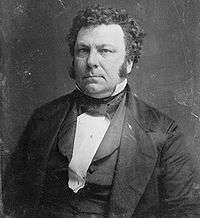 James Alfred Pearce |
March 4, 1835 – March 3, 1839 |
24th 25th |
Whig | [data unknown/missing] |
| 18 |  Philip Francis Thomas |
March 4, 1839 – March 3, 1841 |
26th | Democratic | [data unknown/missing] |
| 19 |  James Alfred Pearce |
March 4, 1841 – March 3, 1843 |
27th | Whig | [data unknown/missing] |
| 20 | Francis Brengle | March 4, 1843 – March 3, 1845 |
28th | Whig | [data unknown/missing] |
| 21 | Thomas Johns Perry | March 4, 1845 – March 3, 1847 |
29th | Democratic | [data unknown/missing] |
| 22 | 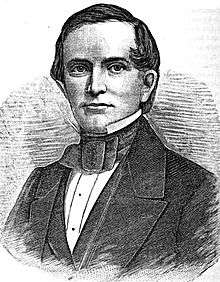 James Dixon Roman |
March 4, 1847 – March 3, 1849 |
30th | Whig | [data unknown/missing] |
| 23 |  William Thomas Hamilton |
March 4, 1849 – March 3, 1853 |
31st 32nd |
Democratic | [data unknown/missing] Redistricted to the 5th district. |
| 24 | Jacob Shower | March 4, 1853 – March 3, 1855 |
33rd | Democratic | [data unknown/missing] |
| 25 |  James Barroll Ricaud |
March 4, 1855 – March 3, 1859 |
34th 35th |
Know Nothing | [data unknown/missing] |
| 26 | 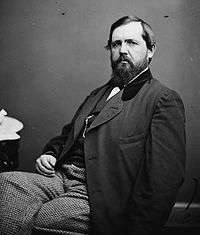 Edwin Hanson Webster |
March 4, 1859 – March 3, 1861 |
36th 37th 38th 39th |
Know Nothing | [data unknown/missing] |
| March 4, 1861 – March 3, 1863 |
Unionist | [data unknown/missing] | |||
| March 4, 1863 – July 1865 |
Unconditional Unionist | [data unknown/missing] | |||
| Vacant | July 1865 – December 4, 1865 | ||||
| 27 | 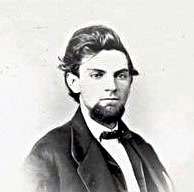 John Lewis Thomas Jr. |
December 4, 1865 – March 3, 1867 |
39th | Unconditional Unionist | [data unknown/missing] |
| 28 | 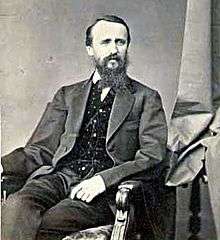 Stevenson Archer |
March 4, 1867 – March 3, 1875 |
40th 41st 42nd 43rd |
Democratic | [data unknown/missing] |
| 29 |  Charles Boyle Roberts |
March 4, 1875 – March 3, 1879 |
44th 45th |
Democratic | [data unknown/missing] |
| 30 | 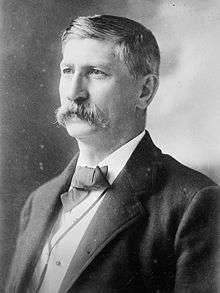 Joshua Frederick Cockey Talbott |
March 4, 1879 – March 3, 1885 |
46th 47th 48th |
Democratic | [data unknown/missing] |
| 31 | Frank Thomas Shaw | March 4, 1885 – March 3, 1889 |
49th 50th |
Democratic | [data unknown/missing] |
| 32 | .jpg) Herman Stump |
March 4, 1889 – March 3, 1893 |
51st 52nd |
Democratic | [data unknown/missing] |
| 33 |  Joshua Frederick Cockey Talbott |
March 4, 1893 – March 3, 1895 |
53rd | Democratic | [data unknown/missing] |
| 34 | William Benjamin Baker | March 4, 1895 – March 3, 1901 |
54th 55th 56th |
Republican | [data unknown/missing] |
| 35 |  Albert Alexander Blakeney |
March 4, 1901 – March 3, 1903 |
57th | Republican | [data unknown/missing] |
| 36 |  Joshua Frederick Cockey Talbott |
March 4, 1903 – October 5, 1918 |
58th 59th 60th 61st 62nd 63rd 64th 65th |
Democratic | [data unknown/missing] Died. |
| Vacant | October 5, 1918 – November 5, 1918 | ||||
| 37 | 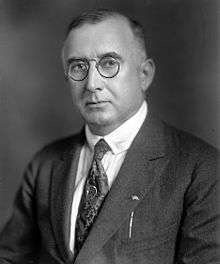 Carville Dickinson Benson |
November 5, 1918 – March 3, 1921 |
65th 66th |
Democratic | [data unknown/missing] |
| 38 |  Albert Alexander Blakeney |
March 4, 1921 – March 3, 1923 |
67th | Republican | [data unknown/missing] |
| 39 | 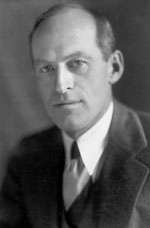 Millard Evelyn Tydings |
March 4, 1923 – March 3, 1927 |
68th 69th |
Democratic | [data unknown/missing] |
| 40 | .jpg) William Purington Cole Jr. |
March 4, 1927 – March 3, 1929 |
70th | Democratic | [data unknown/missing] |
| 41 | Linwood Leon Clark | March 4, 1929 – March 3, 1931 |
71st | Republican | [data unknown/missing] |
| 42 | William Purington Cole Jr. | March 4, 1931 – October 26, 1942 |
72nd 73rd 74th 75th 76th 77th |
Democratic | [data unknown/missing] Resigned to become judge of US Customs Court |
| Vacant | October 26, 1942 – January 3, 1943 | ||||
| 43 | Harry Streett Baldwin | January 3, 1943 – January 3, 1947 |
78th 79th |
Democratic | [data unknown/missing] |
| 44 | Hugh Allen Meade | January 3, 1947 – January 3, 1949 |
80th | Democratic | [data unknown/missing] |
| 45 | William P. Bolton | January 3, 1949 – January 3, 1951 |
81st | Democratic | [data unknown/missing] |
| 46 | 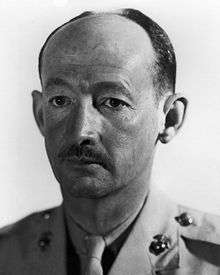 James Patrick Sinnott Devereux |
January 3, 1951 – January 3, 1959 |
82nd 83rd 84th 85th |
Republican | [data unknown/missing] |
| 47 |  Daniel Baugh Brewster |
January 3, 1959 – January 3, 1963 |
86th 87th |
Democratic | [data unknown/missing] |
| 48 |  Clarence Dickinson Long |
January 3, 1963 – January 3, 1985 |
88th 89th 90th 91st 92nd 93rd 94th 95th 96th 97th 98th |
Democratic | [data unknown/missing] |
| 49 | 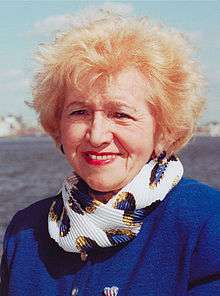 Helen Delich Bentley |
January 3, 1985 – January 3, 1995 |
99th 100th 101st 102nd 103rd |
Republican | Elected in 1984. Re-elected in 1986. Re-elected in 1988. Re-elected in 1990. Re-elected in 1992. Retired to run for Governor of Maryland. |
| 50 |  Bob Ehrlich |
January 3, 1995 – January 3, 2003 |
104th 105th 106th 107th |
Republican | Elected in 1994. Re-elected in 1996. Re-elected in 1998. Re-elected in 2000. Retired to run for Governor of Maryland. |
| 51 |  Dutch Ruppersberger |
January 3, 2003 – Present |
108th 109th 110th 111th 112th 113th 114th 115th 116th |
Democratic | Elected in 2002. Re-elected in 2004. Re-elected in 2006. Re-elected in 2008. Re-elected in 2010. Re-elected in 2012. Re-elected in 2014. Re-elected in 2016. Re-elected in 2018. |
Historical district boundaries
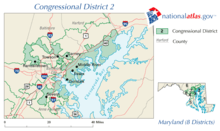
References
- https://www.census.gov/mycd/?st=24&cd=02
- "Partisan Voting Index – Districts of the 115th Congress" (PDF). The Cook Political Report. April 7, 2017. Retrieved April 7, 2017.
- Parsons, Stanley B., William W. Beach and Dan Hermann. United States Congressional Districts 1788-1841 (Westport: Greenwood Press, 1978) p. 9
- Martis, Kenneth C. Historical Atlas of Political Parties in Congress. (New York: Macmillan, 1989) p. 76
- Martis. Historical Atlas. p. 93
- Martis. Historical Atlas. p. 97
- Martis. Historical Atlas. p. 107
- Martis. Historical Atlas. p. 117
- Martis. Historical Atlas. p. 127.
- Historical Maps of Maryland
- Martis. Historical Atlas. p. 155
- Martis. Historical Atlas, p. 157.
- Martis. Historical Atlas. p. 215
- Martis. Historical Atlas. p. 217.
- Martis. Historical Atlas. p. 237
- Lazarick, Len (3 October 2012). "Maryland has least compact congressional districts in nation". MarylandReporter.com. Retrieved 7 October 2012.